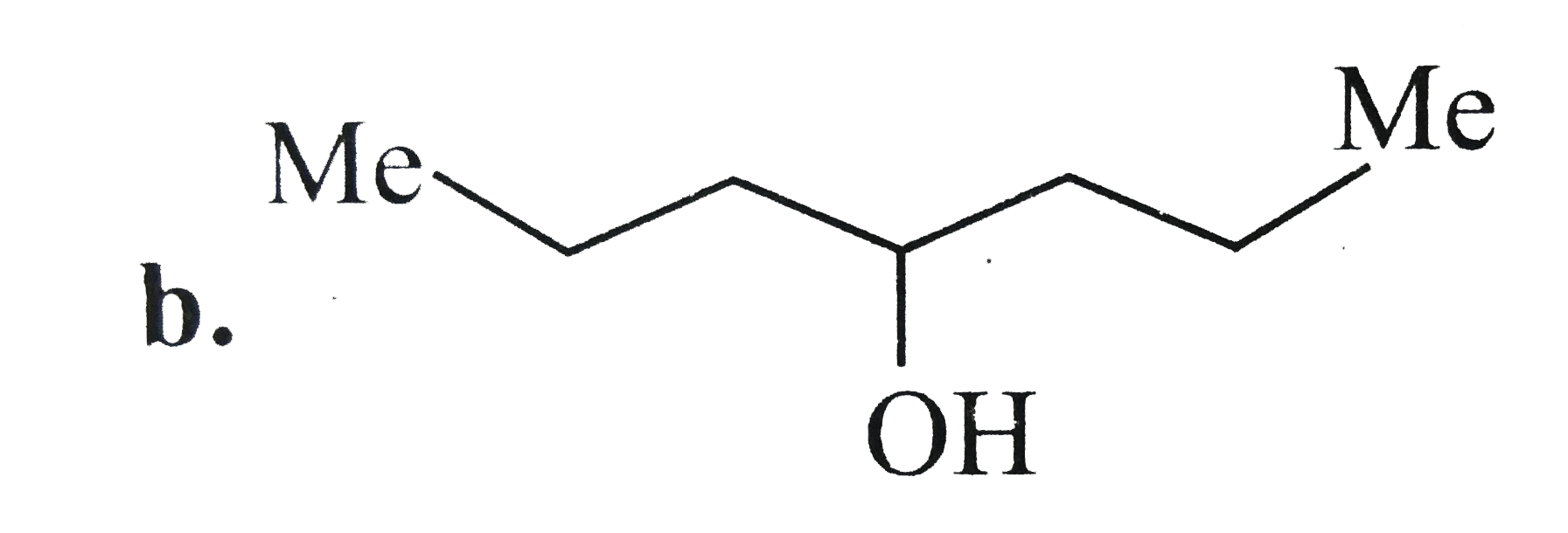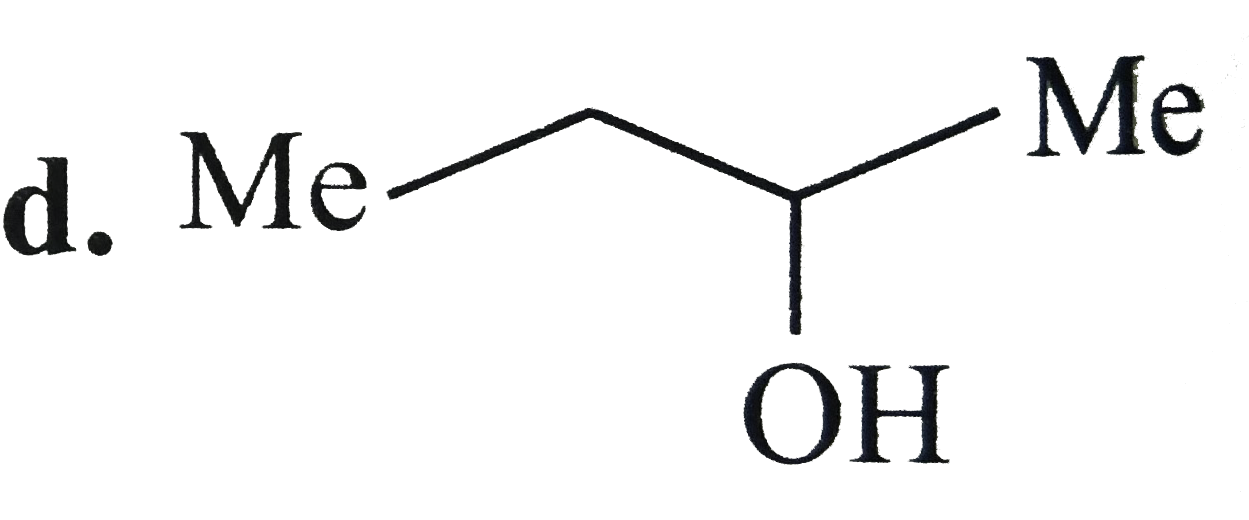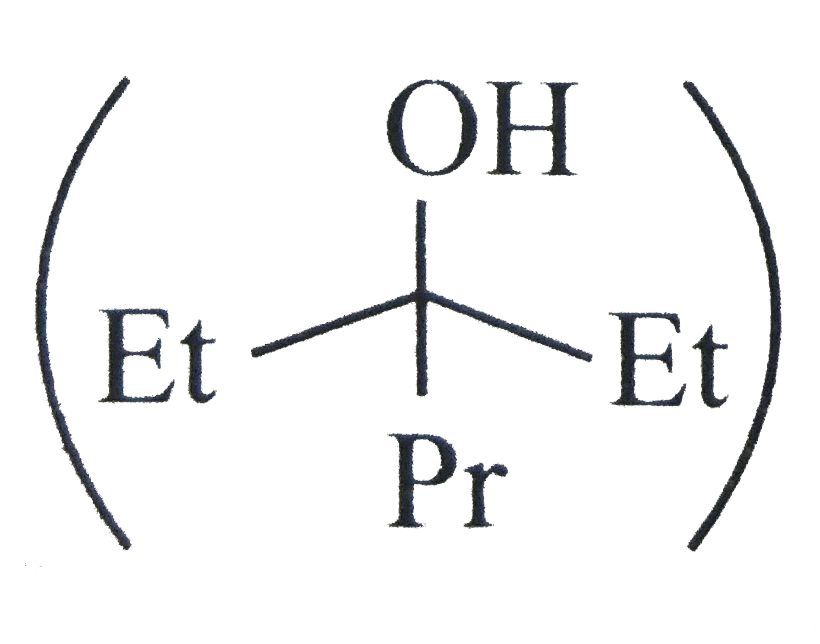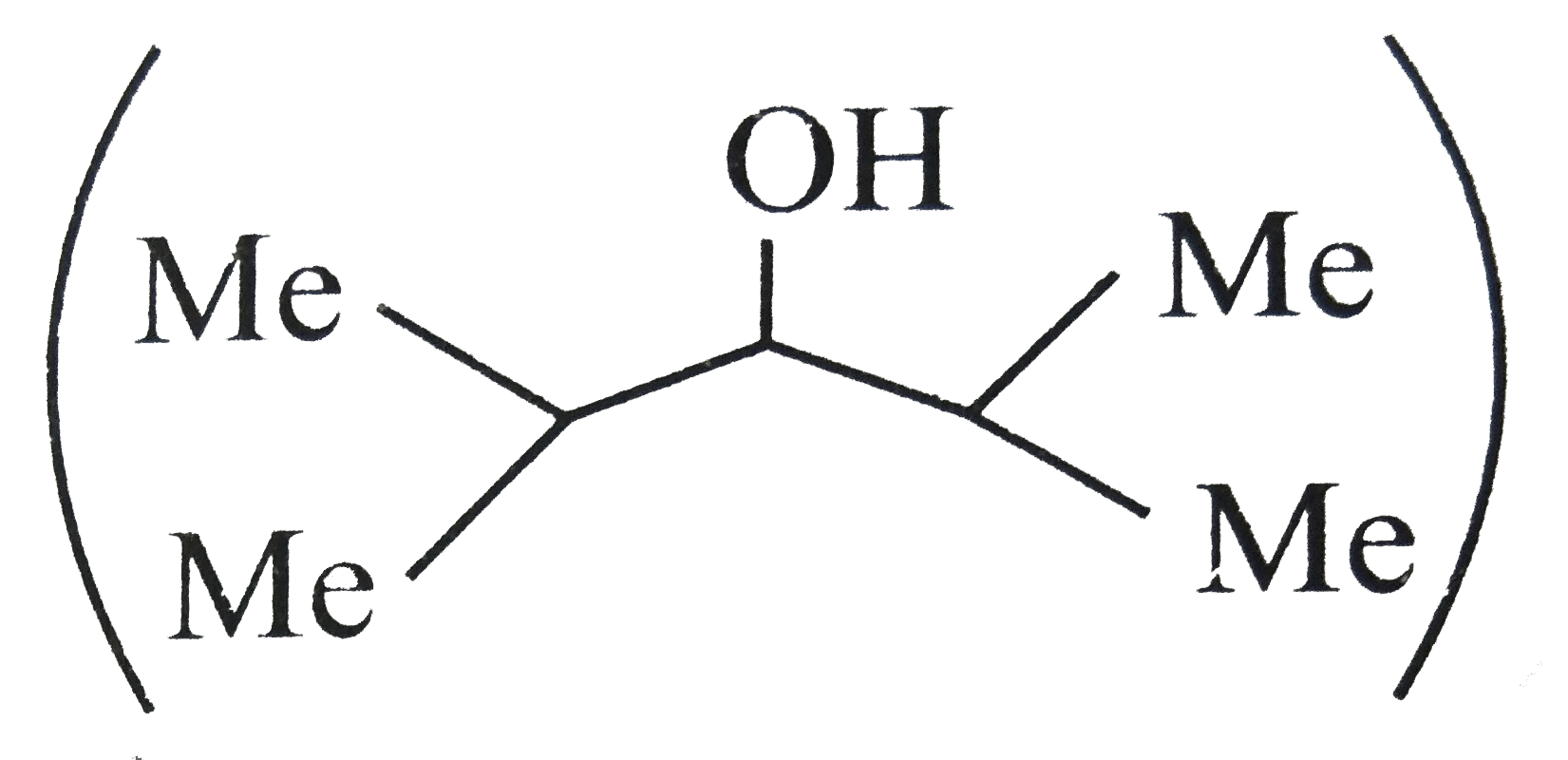Ethyl ester reacts with PrMgBr to give 2∘ alcohol. The alcohol is :




The correct Answer is:B
To solve the problem of determining the two-degree alcohol formed when ethyl ester reacts with propyl magnesium bromide (PrMgBr), we can follow these steps:
1. Identify the Reactants:
- The reactant is ethyl ester, which can be represented as RCOOEt (where R is a hydrogen atom in this case, as we are not given any other substituent).
- The Grignard reagent is propyl magnesium bromide (PrMgBr), which can be represented as C3H7MgBr.
2. Structure of Ethyl Ester:
- Ethyl ester can be depicted as CH3CH2C(=O)OEt. For our case, it simplifies to CH3CH2C(=O)O-H (since R is hydrogen).
3. Reaction with Grignard Reagent:
- When ethyl ester reacts with PrMgBr, the carbonyl carbon (C=O) of the ester is electrophilic and will react with the nucleophilic propyl group (C3H7).
- The reaction leads to the formation of a tetrahedral intermediate where the oxygen becomes negatively charged.
4. Formation of Intermediate:
- The propyl group attacks the carbonyl carbon, resulting in the formation of an intermediate where the ethoxy group (OEt) leaves as a leaving group, forming a new compound:
- R-C(OH)(C3H7)-O-MgBr (where R is hydrogen).
5. Second Reaction with Grignard Reagent:
- The intermediate can react again with another equivalent of PrMgBr. The oxygen will again become negatively charged, and the carbon will be positively charged.
- The propyl group will attack the carbon, leading to a new intermediate.
6. Hydrolysis:
- Upon hydrolysis (usually with water or dilute acid), the magnesium bromide complex will break down, and we will obtain the final product.
- The final product will be a two-degree alcohol:
- The structure will be C3H7-C(OH)-C3H7 (where the hydroxyl group is attached to a carbon that is bonded to two other carbon atoms).
7. Identify the Product:
- The resulting compound is 2-propanol (isopropanol), which is a two-degree alcohol since the carbon with the hydroxyl group is attached to two other carbon atoms.
Final Answer:
The two-degree alcohol formed is 2-propanol (isopropanol).
- The reactant is ethyl ester, which can be represented as RCOOEt (where R is a hydrogen atom in this case, as we are not given any other substituent).
- The Grignard reagent is propyl magnesium bromide (PrMgBr), which can be represented as C3H7MgBr.
- Ethyl ester can be depicted as CH3CH2C(=O)OEt. For our case, it simplifies to CH3CH2C(=O)O-H (since R is hydrogen).
- When ethyl ester reacts with PrMgBr, the carbonyl carbon (C=O) of the ester is electrophilic and will react with the nucleophilic propyl group (C3H7).
- The reaction leads to the formation of a tetrahedral intermediate where the oxygen becomes negatively charged.
- The propyl group attacks the carbonyl carbon, resulting in the formation of an intermediate where the ethoxy group (OEt) leaves as a leaving group, forming a new compound:
- R-C(OH)(C3H7)-O-MgBr (where R is hydrogen).
- The intermediate can react again with another equivalent of PrMgBr. The oxygen will again become negatively charged, and the carbon will be positively charged.
- The propyl group will attack the carbon, leading to a new intermediate.
- Upon hydrolysis (usually with water or dilute acid), the magnesium bromide complex will break down, and we will obtain the final product.
- The final product will be a two-degree alcohol:
- The structure will be C3H7-C(OH)-C3H7 (where the hydroxyl group is attached to a carbon that is bonded to two other carbon atoms).
- The resulting compound is 2-propanol (isopropanol), which is a two-degree alcohol since the carbon with the hydroxyl group is attached to two other carbon atoms.
The two-degree alcohol formed is 2-propanol (isopropanol).
Topper's Solved these Questions
- GRIGNARD REAGENTS AND ORGANOMETALLIC REAGENTSBOOK - CENGAGE CHEMISTRY ENGLISHCHAPTER - GRIGNARD REAGENTS AND ORGANOMETALLIC REAGENTSEXERCISE - Exercises Archives (Single Correct)
4 Videos
- GRIGNARD REAGENTS AND ORGANOMETALLIC REAGENTSBOOK - CENGAGE CHEMISTRY ENGLISHCHAPTER - GRIGNARD REAGENTS AND ORGANOMETALLIC REAGENTSEXERCISE - Exercises Archives (True/False)
1 Video
- GRIGNARD REAGENTS AND ORGANOMETALLIC REAGENTSBOOK - CENGAGE CHEMISTRY ENGLISHCHAPTER - GRIGNARD REAGENTS AND ORGANOMETALLIC REAGENTSEXERCISE - Exercises (Multiple Correct)
16 Videos
- GENERAL PRINCIPLES AND PROCESS OF ISOLATION OF ELEMENTSBOOK - CENGAGE CHEMISTRY ENGLISHCHAPTER - GENERAL PRINCIPLES AND PROCESS OF ISOLATION OF ELEMENTSEXERCISE - Archives (Subjective)
14 Videos
- NCERT BASED EXERCISEBOOK - CENGAGE CHEMISTRY ENGLISHCHAPTER - NCERT BASED EXERCISEEXERCISE - Nuclear Chemistry (NCERT Exercise)
29 Videos
Similar Questions
Methyl ester reacts with EtMgBr to give 3∘ alcohol
 The ester is :
The ester is :
View SolutionPropyl ester reacts with isopropyl magnesium bromide to give 2∘ alcohol
 The ester is :
The ester is :
View SolutionSome word/words are missing/written wrong in the following statement. You are required to rewrite the statement in the correct form using the appropriate word/words
Ethyl chloride reacts with Potassium hydroxide to give ethyl alcohol.
View SolutionBenzyl alcohol reacts with PCl5 to give:
View SolutionBenzaldehyde reacts with alcoholic KCN to give :
View SolutionBenzaldehyde reacts with alcoholic KCN to give :
View SolutionHow will you convert ethyl alcohol to methyl alcohol ?
View SolutionThe correct order of reactivity of hydrogen halides with ethyl alcohol is
View SolutionState how the following conversions can be carried out:
(i) Ethyl chloride to Ethyl alcohol.
(ii) Ethyl chloride to Ethene.
(iii) Ethene to Ethyl alcohol.
(iv) Ethyl alcohol to Ethene.
View SolutionThe rate of esterification of acetic acid with methyl alcohol (I) , ethyl alcohol (II) , isopropyl alcohol (III) and teritary butyl alcohol ( IV) follow in the order -
View Solution